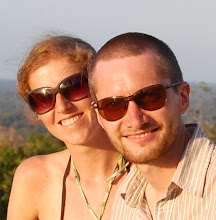Tuesday, October 20, 2009
Okarito Kiwi Spotting
Okarito is a very small township about 25km from Franz Josef. Population: 35. One of those people is a guy called Ian from Hertfordshire, who runs nightly birdwatching tours in the nearby Pakihi reserve, which is a designated kiwi habitat.
Ian has the right attitude for a nature guide: he doesn't feed the birds, he doesn't chase the birds, and he tries his absolute hardest not to disturb the birds or disrupt their natural behaviour. He manages to enable people like us to see kiwis in their natural habitat because he knows the birds in the area and their behaviour.
We started the evening with a thorough breifing from Ian. Kiwis are territorial birds, and a breeding pair's territory can be about 60 times the area of a football pitch. In the reserve where we were headed, there were just 3 pairs; 6 birds in an area 180 times the size of a football pitch. What's more, we were restricted to the relatively tiny area of the track that passed through the 3 pairs' territories. (Bashing through the dense bush looking for kiwis is pointless - there's no chance of hearing a kiwi over the noise, not to mention the fact that they'd all be scared off!) A guide is obviously essential.
On the way into the reserve - dressed in our fetching mosquito hats and sporting high-viz safety vests to avoid being shot by deer hunters - we saw a couple of classic tell-tale kiwi clues. Firstly, a fresh track laid by an adult kiwi. To give you an idea of scale, the left and right toes are about 10cm apart at the tips (if you were to make that photo onto a 6x4" print, it would be approximately life-sized). Further down the track, some pretty fresh, and surprisingly large, kiwi poo. It has a white crust and smells not like normal animal dung, but strongly of ammonia.
As it happens, one of the three kiwi pairs is currently incubating an egg in their burrow, which is pretty close to the track. Kiwis are nocturnal birds, but they get up about 20 minutes before sunset to start feeding. We positioned ourselves near the burrow on the track, and waited in silent anticipation.
As the light faded, we wondered whether we might be out of luck tonight (see previous post from the Bay of Islands re dolphin spotting). But, in the fading light of dusk, we spotted the female kiwi strutting by, searching the bush for grubs and insects. Amazing! We were now part of a very elite group: only about 0.5% of New Zealanders have seen kiwis in the wild. I don't know what proportion of foreign tourists have done the same, but we're two of them!
The night had started well, but there was more to come. We followed the kiwi, keeping silent and listening for any sounds she made, as she moved around the bush. After a pretty long time standing virtually motionless and silent, we could hear her heading back towards us and out onto the path. By this time it was completely dark, so we needed special low-intensity red torchlight to see the bird (which, by the way, didn't seem to bother her one bit). She snuffled around at the edge of the path just a few metres away from us, then ran across to the other side, hopping from foot to foot. Our patience certainly paid off!
This is now up there as one of our best wildlife spotting moments, no doubt about it. A wild kiwi, in her natural habitat. Does NZ get better than that?
Rob
Subscribe to:
Post Comments (Atom)











No comments:
Post a Comment